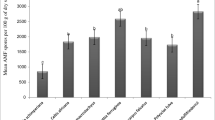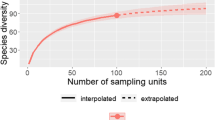Abstract
The populations of vesicular-arbuscular mycorrhizae (VAM) propagules by the most probable number method in some mollisols and their correlations with some important soil properties were determined. On average, the six soils, Phoolbagh clay loam, Beni silty clay loam, Haldi loam, Nagla loam, Khamia sandy loam and Patherchatta sandy loam contained 4.9, 4.0, 7.9, 7.9, 3.3 and 13.0 propagules/g soil, respectively, i.e. none of the soils was found to be high in VAM. The size of the VAM population was compared to soil properties such as pH, organic carbon, sand content, available phosphorus and available potassium, cation-exchange capacity, silt and clay contents. A significant positive correlation (r=0.586) was only found with available soil phosphorus (P<0.05) and a significant negative correlation (r=-0.555) with soil clay content (P<0.05).
Similar content being viewed by others
References
Alexander M (1982) Most probable number method for microbial population. In: Black CA (ed) Methods of soil analysis, part 2: Chemical and microbiological properties. American Society of Agronomy, Madison, Wis, pp 1467–1472
Daniels BA, Skipper HD (1982) Methods for the recovery and quantitative estimation of propagules from soil. In: Schenck NC (ed) Methods and principles of mycorrhizal research. American Phytopathology Society, St Paul, Minn, pp 29–35
Deshpande SB, Fehrenbacher JB, Beavers AH (1971) Mollisols of Tarai region of Uttar Pradesh, Northern India. I. Morphology and mineralogy. II. Genesis and classification. Geoderma 6:179–195
Hayman DS (1970) Endogone spore numbers in soil and vesicular-arbuscular mycorrhizae in wheat as influenced by season and soil treatment. Trans Br Mycol Soc 54:53–63
Hayman DS, Stonold GE (1979) Spore populations and infectivity of vesicular-arbuscular mycorrhizal fungi in New South Wales. Aust J Bot 27:227–233
Hiremath PC, Harini Kumar KM, Patil CV (1990) Density of vesicular-arbuscular mycorrhizal fungi in different crops grown under black soil. In: Jalali BL, Chand H (eds) Current trends in mycorrhizal research. Haryana Agricultural University, Hisar, India, pp 20–21
Kruckelmann HW (1975) Effects of fertilizers, soil, soil tillage and plant species on the frequency of Endogone chlamydospores and mycorrhizal infection in arable soils. In: Sanders PE, Mosse B, Tinker PB (eds) Endomycorrhizas. Academic Press, London, pp 511–525
Peter D, Christensen M (1982) Mycorrhizal fungi associated with Bouteloua and Agrophyron in Wyoming sage brush grasslands. Mycologia 74:877–885
Phillips JM, Hayman DS (1970) Improved techniques for clearing roots and staining parasitic and VAM fungi for rapid assessment of infection. Trans Br Mycol Soc 55:158–161
Porter WM (1979) The most probable number method for enumerating infective propagules of vesicular-arbuscular mycorrhizal fungi in soil. Aust J Soil Res 117:515–519
Powell CL (1980) Mycorrhizal infectivity of eroded soils. Soil Biol Biochem 12:247–250
Rao VP, Pawar SE, Singh SN (1990) Distribution and intensity of native VAM in the Maharashtra region. In: Jalali BL, Chand H (eds) Current trends in mycorrhizal research. Haryana Agricultural University, Hisar, India, pp 162–163
Shukla BN, Vanjare N (1990) Extraction of vesicular-arbuscular mycorrhizae spores and effect of fertilizers on their population in oilseeds cropped soils. In: Jalali BL, Chand H (eds) Current trends in mycorrhizal research. Haryaha Agricultural University, Hisar, India, pp 33–34
Singh HP (1983) Studies on the interactions among rock phosphate, Rhizobium, mycorrhiza and phosphate solubilizers. PhD thesis, G. B. Pant University, Pantnagar, India
Vyas A, Srivastava HP (1987) Studies on vesicular-arbuscular mycorrhizae of mothbean. In: Varma AK, Oka AK, Mukerji KG, Tilak KVBR, Raj J (eds) Mycorrhiza round table. Jawaharlal Nehru University, New Delhi, pp 306–312
Author information
Authors and Affiliations
Additional information
Directorate research paper series No. 7862
Rights and permissions
About this article
Cite this article
Rathore, V.P., Singh, H.P. Quantification and correlation of vesicular-arbuscular mycorrhizal propagules with soil properties of some mollisols of northern India. Mycorrhiza 5, 201–203 (1995). https://doi.org/10.1007/BF00203338
Issue Date:
DOI: https://doi.org/10.1007/BF00203338




